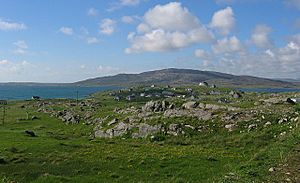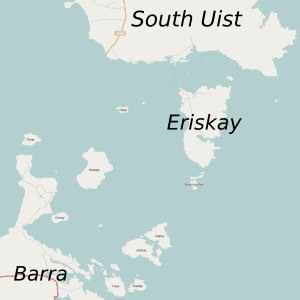Eriskay facts for kids
| Gaelic name | Èirisgeigh |
|---|---|
| Norse name | Eiriksey |
| Meaning of name | Eric's Isle |
| OS grid reference | NF795104 |
| Coordinates | 57°04′N 7°17′W / 57.07°N 7.29°W |
| Physical geography | |
| Island group | Uist and Barra |
| Area | 703 ha (2.71 sq mi) |
| Area rank | 63 |
| Highest elevation | Beinn Sgrithean 185.6 m (609 ft) |
| Administration | |
| Sovereign state | United Kingdom |
| Country | Scotland |
| Council area | Comhairle nan Eilean Siar |
| Demographics | |
| Population | 143 |
| Population density | 20.3/km2 (53/sq mi) |
Eriskay (Scottish Gaelic: Èirisgeigh) is a small island in northern Scotland. Its name comes from the Old Norse words meaning "Eric's Isle". Eriskay is part of the Outer Hebrides islands. In 2011, about 143 people lived there.
The island is located between South Uist and Barra. A special road called a causeway connects Eriskay to South Uist. This causeway opened in 2001. In the same year, Ceann a' Ghàraidh in Eriskay became a ferry port. From here, you can take a ferry to Ardmore in Barra. The ferry trip takes about 40 minutes.
Contents
What Makes Eriskay Famous?
Even though Eriskay is a small island, it's known for many interesting things. It's only about 4 kilometers (2.5 miles) long and 2.5 kilometers (1.5 miles) wide.
Songs and Special Animals
Eriskay is famous for a traditional island song called the Eriskay Love Lilt. The island also has its own special horse, the Eriskay Pony. People also make a unique type of sweater here called the Eriskay jersey, which is made without any seams.
The Shipwreck Story
Eriskay is known as the "Whisky Galore! island." This is because a ship called the SS Politician ran aground nearby in 1941. The ship was carrying a lot of cargo. This event later inspired a famous book and movie.
Bonnie Prince Charlie's Landing
A very important historical event happened on Eriskay. On August 2, 1745, a ship landed Bonnie Prince Charlie on the island. He was with his "seven men of Moidart". This landing marked the start of the "Forty-Five Jacobite Rising", a big event in Scottish history.
An Early Film About Island Life
In 1934, a German traveler named Werner Kissling made an important documentary film on Eriskay. It was called Eriskay: A Poem of Remote Lives. The film showed what life was like on the island.
Island Life and Community
Eriskay has a shop where you can buy things. There is also a community center for island events. The Politician Lounge Bar is a local pub, named after the famous shipwreck.
The Roman Catholic church of St Michael's is on a hill. It looks over the main village. This church was built in 1903 by Father Allan MacDonald. It celebrated its 100th birthday in 2003. A memorial garden with a statue of the Virgin Mary marks the spot of the old church. It overlooks the Sound of Barra.
Getting Around Eriskay
Eriskay has many paths for walking and hiking. There is only one main road for cars. The first part of this road was built in 1935. Money for the road came from the first showing of Werner Kissling's film in London.
Bus Services
There is a regular bus service on the island. It is part of a longer route called the "Spine Route." This route connects Eriskay Slipway to Berneray. It travels through South Uist, Benbecula, and North Uist. DA Travel provides these bus services. Comhairle nan Eilean Siar helps fund them.
Harbors and Boats
In 2009, the harbor facilities at Acarsaid Mhòr were improved. This natural harbor now has better access for vehicles. Some smaller fishing boats still use the bay at Haun. Haun means 'harbor' in Viking language. However, it doesn't offer much shelter from the weather. Acarsaid Mhòr is also used by boats visiting the island.
Crofting on Eriskay
Crofting is a special way of farming in Scotland. It involves small farms called crofts. In the 1880s, Eriskay and Stack Island became part of several crofting areas. These areas are called townships.
Eriskay's Crofting Townships
There are several crofting townships on Eriskay:
- Acarsaid Mhòr – 14 crofts
- Am Baile (Balla) – 16 crofts
- Bun a' Mhuillinn – 10 crofts
- Coilleag – 10 crofts
- Na Hann (Haun) – 6 crofts
- Na Pàirceannan (Parks) – 4 crofts
- Roisinis (Roshinish) – 4 crofts
- Rudha Bàn – 9 crofts
In total, there are 73 crofts on the island.
Grazing Rights and Animals
Each croft has rights to let animals graze on common land. This common land is the high ground of Beinn Sgrithean and Beinn Stac. For each full share, a crofter can have ten sheep, two cows, and one Eriskay Pony. They can also have their young animals (up to one year old). Most crofts have one full share. Some have half a share, and a few have more.
Challenges for Crofting Today
The crofts on Eriskay are small. They are often five hectares or less. The land is rocky and faces harsh weather. Today, not many crofts are actively worked. It takes a lot of effort for little money. People still feel a strong connection to the land. However, modern life leaves less time for farming.
Some of the best grazing land has been used for building houses. Also, people are less keen on letting cattle and sheep roam freely in winter. Now, the most active crofts are in Bun a' Mhuillin. The Eriskay Grazings Committee manages the common grazing lands. They follow rules from the Crofting Acts.
Community Takes Control
In 2006, the people of Eriskay took control of their island. This was after a long effort by the community. The previous owners were a group that owned a large estate. This estate included Benbecula, South Uist, and Eriskay. The community bought the land for £4.5 million. They set up an organization called Stòras Uibhist to buy and manage the land forever.
Why People Leave Eriskay

Many families have left Eriskay over the years. They often leave to find work. Some old island families now have very few or no relatives left on the island. For example, the Clan MacInnes family was once very important. Now, only four members of their extended family live on Eriskay. They work in crofting, fishing, and building.
Young people often leave for the mainland. This is because there are not many job opportunities on the island. Also, it can be hard to get further education there.
In 2011, the island's population was 143 people. This was a small increase from 133 people in 2001. During the same time, the population of all Scottish islands grew by 4%.
Visiting Eriskay
Tourism has been slow to grow on Eriskay. As of 2010, there were no hotels. There were only a few bed and breakfast places. Not many self-catering cottages were available either.
Since the causeway to South Uist opened in 2001, things have changed. Also, the vehicle ferry to Barra started running. Now, more properties have been fixed up or built for holiday visitors. The sandy areas and beaches are becoming popular with people who travel with their motor-homes.
Eriskay's Unique Plants
Sea bindweed grows on Eriskay. This plant is not usually found in the Hebrides. People say it arrived when Bonnie Prince Charlie landed. The story goes that he accidentally dropped the seeds from his pocket.
Famous People Connected to Eriskay
- Allan MacDonald (1859–1905) was a Roman Catholic priest and Scottish Gaelic poet. He also worked to help crofters. He lived on Eriskay.
- Prince Charles and Princess Diana visited the island in July 1985. This was during their trip to the Western Isles.
- Father Calum (Malcolm Joseph) MacLellan (1926–2012) was a priest. He appeared in a TV series called An Island Parish. He was also the first vice-convener of Comhairle nan Eilean Siar.



